Budapest in two days: The perfect 48-hour itinerary
8am to 12 noon

Breakfast
Start your day early with breakfast at one of Budapest’s many traditional coffee houses and cafés. Whether you prefer a light breakfast of coffee and a pastry, a fuller meal with cold meats, eggs, and toast, or Hungarian breakfast staples like traditional scrambled eggs, omelettes, and bundás kenyér (Hungarian savoury French toast), it will set you up for a full morning of sightseeing.
Recommended cafés:
- Gerlóczy Kávéház in Pest | Find on map
Opening hours: 7.30am to 11pm
Nearest hop-on-hop-off bus stop: Synagogue, Dohány utca (BigBus); Astoria (City Sightseeing) - LÁNG Bistro & Grill in Buda | Find on map
Opening hours: 7am to 10.30am, 12 noon to 3pm, 6pm to 11pm
Nearest hop-on-hop-off bus stop: Batthyany Square (BigBus), Batthyány Square (City Sightseeing); Clark Ádám Sq., Lánchíd Street (BigBus); Funicular/Sikló (City Sightseeing)
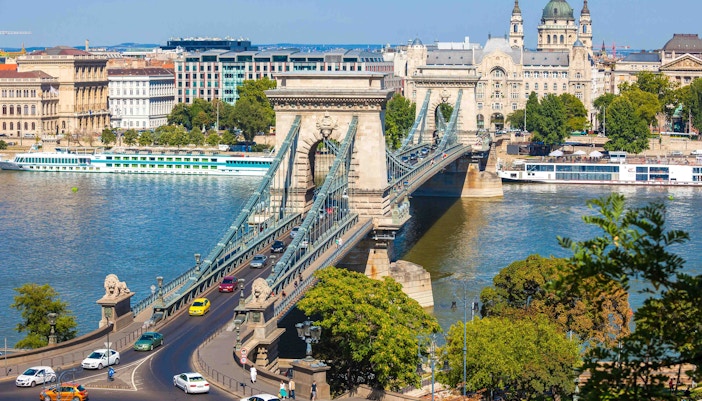
Szechenyi Chain Bridge
Take the first hop-on-hop-off bus and get off near Szechenyi Chain Bridge. Opened in 1849, it is Budapest's first permanent bridge. Stroll across from Pest to the Buda side, taking in the monuments lining the riverbanks and the cityscape on both sides of the Danube. Chain Bridge offers stunning views and opportunities for amazing photographs.
- Opening hours: Throughout the day
- Duration of visit: around 30 minutes
- Nearest hop-on-hop-off bus stop: Chain Bridge, Széchenyi István tér (BigBus); Chain Bridge, Pest (City Sightseeing); Clark Ádám Sq., Lánchíd Street (BigBus); Funicular/Sikló (City Sightseeing)
- Pro-tip: Visit the Chain Bridge early in the morning when there is less traffic and fewer crowds.
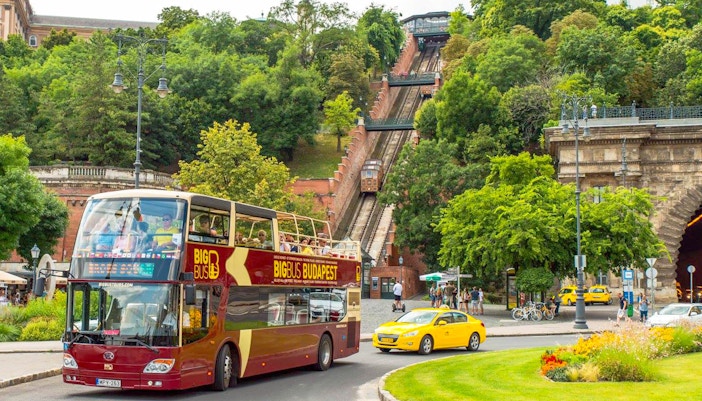
Castle Hill
Dive straight into the history of Budapest with a visit to the Castle District on the Buda side. A UNESCO World Heritage Site, it dates back to the mid-13th century and has withstood more than 30 sieges! Take the historical funicular railway (which opened in 1870) up to Castle Hill, where you can wander the crooked streets and admire the medieval buildings.
- Opening hours: Throughout the day
- Duration of visit: 30 minutes to 1 hour
- Nearest hop-on-hop-off bus stop: Clark Ádám Sq., Lánchíd Street (BigBus); Funicular/Sikló (City Sightseeing)
- Pro-tip: Consider taking a guided walking tour of Castle Hill and its landmarks to learn about its rich history.
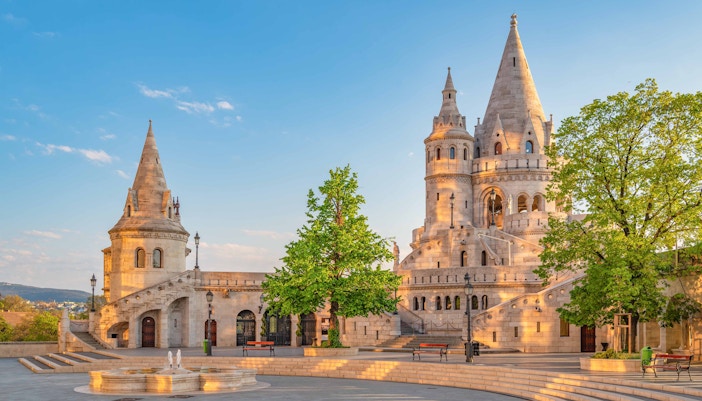
Fisherman’s Bastion
For the best views of Budapest, head to Fisherman’s Bastion on Castle Hill. From its balconies and towers, you get sweeping vistas of the city, particularly the Danube River, Margaret Island, the Chain Bridge, the Hungarian Parliament, and all of Pest. With its fairytale turrets, the Bastion itself is a stunning piece of architecture, and you’ll find yourself taking as many photos of it as the views it provides.
- Opening hours: Throughout the day
- Duration of visit: 30 minutes to 1 hour
- Nearest hop-on-hop-off bus stop: Clark Ádám Sq., Lánchíd Street (BigBus); Funicular/Sikló (City Sightseeing)
- Pro-tip: Fisherman’s Bastion is free to explore before 9am. Its upper towers have an entrance fee from 9am to 7pm. However, the views are worth the charge.
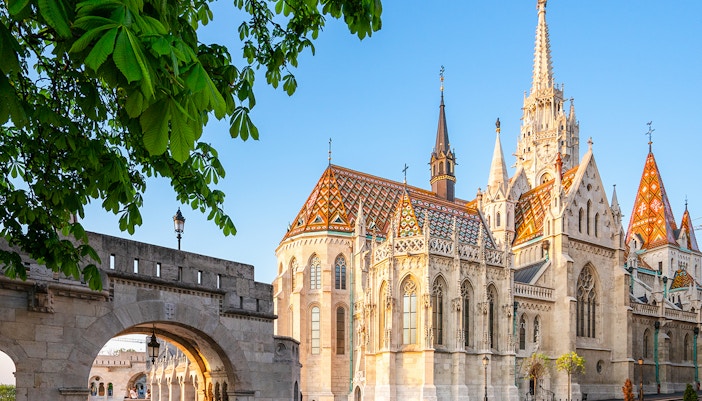
Matthias Church
Right across from Fisherman’s Bastion is the 13th-century Matthias Church, where Hungary’s kings were once crowned. With its Gothic spires and roof decorated in colourful Zsolnay ceramic tiles, it is one of Budapest’s most striking medieval buildings. The interiors are impressive too, with a soaring ceiling, frescoes in vibrant reds, blues, greens, and yellows, and vivid stained glass windows.
- Opening hours: Monday to Friday: 9am – 5pm, Saturday: 9am – 12 noon, Sunday: 1pm – 5pm
- Duration of visit: 1 hour
- Nearest hop-on-hop-off bus stop: Clark Ádám Sq., Lánchíd Street (BigBus); Funicular/Sikló (City Sightseeing)
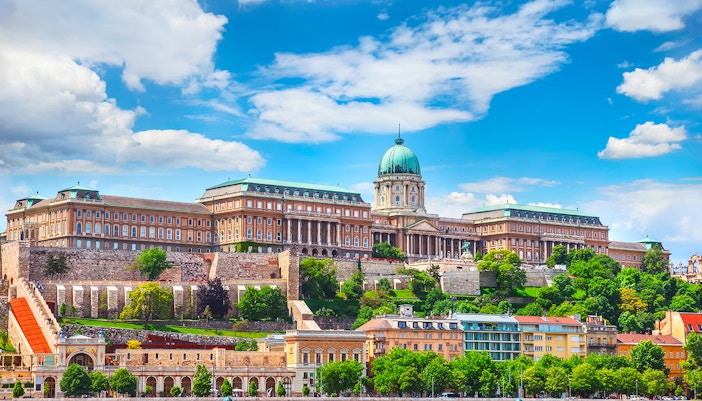
Buda Castle
Once a royal residence, Buda Castle today houses the Hungarian National Gallery and the Budapest History Museum, treasure troves of artworks and artefacts. Spend your morning exploring the 13th-century castle complex, which also includes the castle labyrinth, gardens, statues, fountains, monuments, and the medieval Vienna Gate, all of which encompass centuries of Hungarian heritage.
- Opening hours: 10am – 6pm
- Duration of visit: 2 to 3 hours
- Nearest hop-on-hop-off bus stop: Clark Ádám Sq., Lánchíd Street (BigBus); Funicular/Sikló (City Sightseeing)
- Pro-tip: The grounds, the main courtyard, and the gardens of Buda Castle are free to visit. To explore the museums, book Buda Castle tickets.
12 noon to 6pm

Gellért Thermal Baths
After descending Castle Hill, head to the nearest hop-on hop-off stop and take the next bus to Gellért Thermal Baths. One of Budapest’s most famous historical spas, the Gellért Baths are famous for their Art Nouveau architecture, with intricate mosaics, stained glass windows, and sculptures. You can spend the next couple of hours unwinding in the mineral-rich thermal pools, indulging in spa treatments, and admiring the stunning architecture.
- Opening hours: 9am – 7pm
- Duration of visit: 2 to 2.5 hours
- Nearest hop-on hop-off bus stop: Gellért Bath, opposite Hotel Gellért (BigBus); Gellért Bath (City Sightseeing)
- Pro-tip: If you are not carrying swimsuits and towels, you can rent them at Gellért Baths.
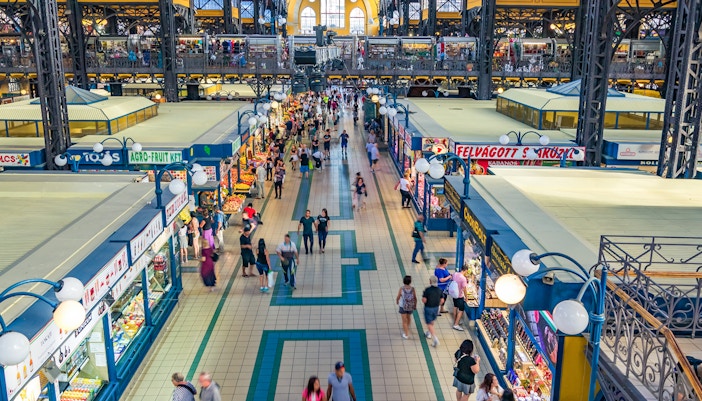
Central Market Hall
Once you’ve pampered yourself at Gellért Baths, cross the Liberty Bridge to head to the Central Market Hall on the Pest side for a spot of lunch and explore Budapest’s oldest and largest indoor market. Inside, you will find hundreds of stalls selling fresh produce, local handicrafts, souvenirs, and traditional cuisine. Don’t forget to try lángos (fried flatbread), kürtőskalács (chimney cake), and Tokaji wine, all of which are Hungarian delicacies.
- Opening hours: Monday: 6am – 5pm; Tuesday to Friday: 6am – 6pm; Saturday: 6am – 3pm
- Closed on: Sunday
- Duration of visit: 1 to 1.5 hours
- Nearest hop-on hop-off bus stop: Gellért Bath, opposite Hotel Gellért (BigBus); Gellért Bath (City Sightseeing); Váci Street, Ferenciek tere (BigBus); Parisi Udvar/Hyatt (City Sightseeing)
- Pro-tip: Most shops and stalls here only accept cash, so remember to carry Hungarian Forints with you.
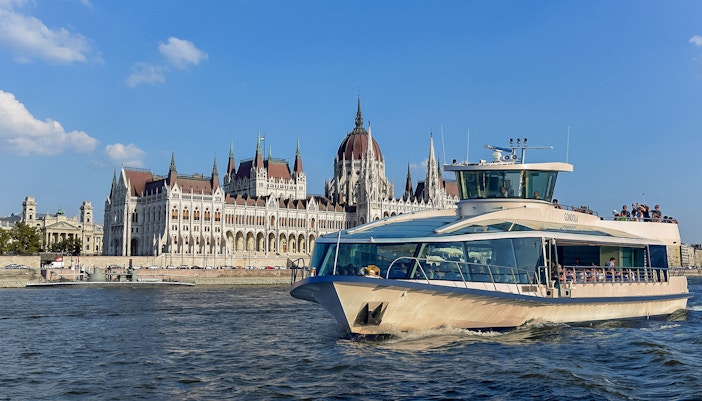
Danube sightseeing cruise
Evenings in Budapest are the perfect time to go on a leisurely Danube sightseeing cruise. A boat on the river is a fantastic spot to see the city and its landmarks, like Buda Castle, the Parliament Building, Chain Bridge, and Gellért Hill, awash in the warm golden glow of sunset. As dusk falls and the boat glides along the river, watch the city lights come on and Budapest transform from day to night.
- Opening hours: 11am – 5.45pm
- Duration of cruise: 1 hour
- Departure point:
- Nearest hop-on hop-off bus stop: Váci Street, Ferenciek tere (BigBus); Parisi Udvar/Hyatt (City Sightseeing)
- Pro-tip: With a hop-on hop-off ticket, you can go on your Danube River cruise anytime between 11am and 5pm. We recommend taking an evening cruise for amazing sunset views.
6pm to 12 midnight – or beyond!
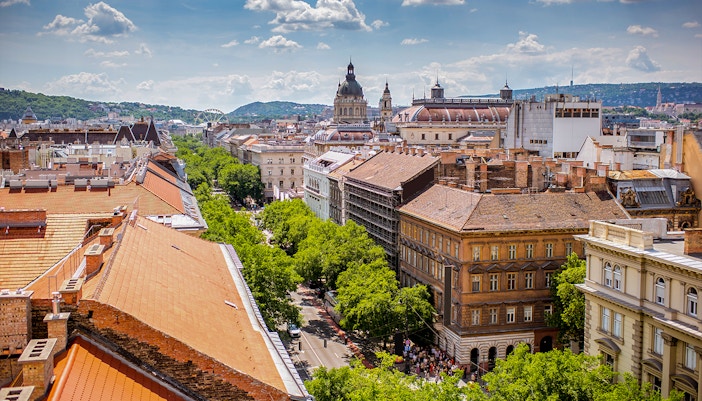
Andrassy Avenue
After your cruise, take the next hop-on hop-off bus to Andrássy Avenue, one of Budapest’s grand boulevards. This elegant street, a UNESCO World Heritage Site, is lined with 19th-century villas, museums, exhibition venues, and cultural attractions. Take a ride on the Budapest Ferris Wheel, one of the tallest in Europe, and soak in the scenic views. Andrássy Avenue is also a gastronomic and shopping destination, boasting upscale boutiques and stores as well as several restaurants, cafés, and bistros.
- Opening hours: Throughout the day
- Duration of visit: 1.5 to 2 hours
- Nearest hop-on hop-off bus stop: Andrássy Avenue (BigBus); Opera House (BigBus); Liszt Ferenc Square (BigBus); Andrássy Avenue (City Sightseeing); Hungarian State Opera House (City Sightseeing); Liszt Ferenc Square (City Sightseeing)

Dinner
Once you’re done shopping or window shopping, it’s time for dinner. Many of Budapest’s best restaurants are located on or near Andrássy Avenue and they offer a wide range of culinary experiences. Try Twentysix Budapest (find on map), a Mediterranean restaurant designed like an indoor jungle. Menza Étterem és Kávéház (find on map) serves classic Hungarian food, like Chicken Paprikash with Hungarian Dumplings. Or dine at Két Szerecsen (find on map), which specializes in Middle Eastern and Mediterranean flavours inspired by Turkish, Lebanese, and Greek cuisines.
- Opening hours: Throughout the day
- Duration of visit: 1.5 to 2 hours
- Nearest hop-on hop-off bus stop: Andrássy Avenue (BigBus); Opera House (BigBus); Liszt Ferenc Square (BigBus); Andrássy Avenue (City Sightseeing); Hungarian State Opera House (City Sightseeing); Liszt Ferenc Square (City Sightseeing)

Ruin pubs
One of the most unique features of Budapest’s nightlife scene are the ruin bars. These are unconventional drinking joints set up in abandoned, shabby buildings and neglected courtyards, each with its own eclectic décor. They can range from party hotspots to mellower venues where you can enjoy relaxing drinks and conversations. Head to the old Jewish Quarter, where these iconic ruin bars originated. Or go on a ruin pub crawl, where a local guide will introduce you to the city’s lively drinking culture and nightlife.
- Recommended ruin bars: Szimpla Kert, Kőleves Kert, UdvarRom, Grandio Jungle Bar, Instant & Fogas Ház
- Nearest hop-on hop-off bus stop: Synagogue, Dohány utca (BigBus); Dohány Street Synagogue (City Sightseeing)
8am to 10am
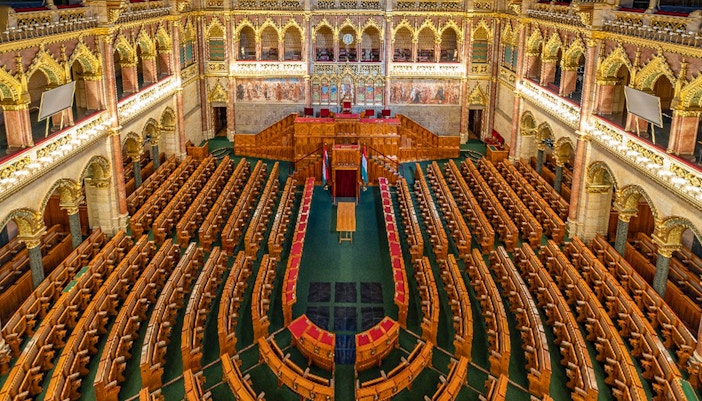
Hungarian Parliament
Begin your second day in Budapest bright and early with a visit to its most iconic building: the Hungarian Parliament. The seat of government, this Gothic Revival architectural masterpiece has equally magnificent interiors, with grand staircases, intricate woodwork, stained glass windows, and frescoes. Take the guided tour of these hallowed halls, and visit the Ethnographic Museum, housed within the building, to learn about Hungarian folk culture, traditions, and history.
- Opening hours: 8am – 4pm
- Duration of visit: 1 hour
- Nearest hop-on hop-off bus stop: Parliament, Bajcsy-Zsilinszky út 60 (BigBus); Parliament (City Sightseeing); Chain Bridge, Széchenyi István tér (BigBus); Chain Bridge, Pest (City Sightseeing)
- Pro-tip: The Hungarian Parliament can only be explored with guided tours. Book your tickets well in advance as this is an extremely popular attraction.
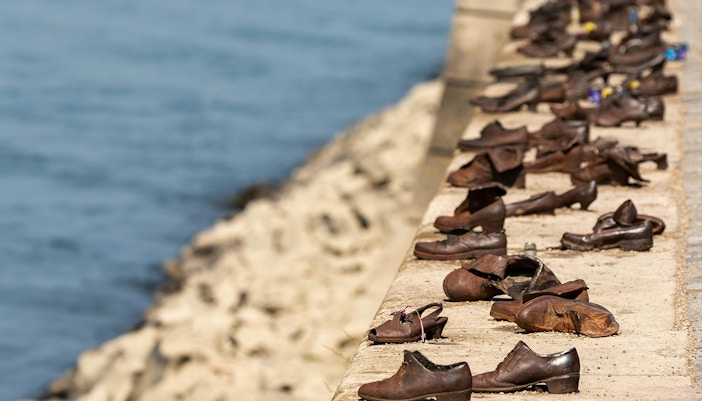
Shoes on the Danube Bank
When you exit the Parliament, walk to the riverbank to see the “Shoes on the Danube Bank”. This public art installation, featuring 60 pairs of iron shoes in different styles and sizes, is a poignant memorial to the Hungarian Jews who were executed by fascist militiamen in the winter of 1944-1945. Before being shot, the victims were ordered to remove their shoes, and their bodies were left to fall into the Danube. It is a solemn reminder of the atrocities committed during World War II.
- Opening hours: Throughout the day
- Duration of visit: 20 to 30 mins.
- Nearest hop-on hop-off bus stop: Chain Bridge, Széchenyi István tér (BigBus); Chain Bridge, Pest (City Sightseeing)
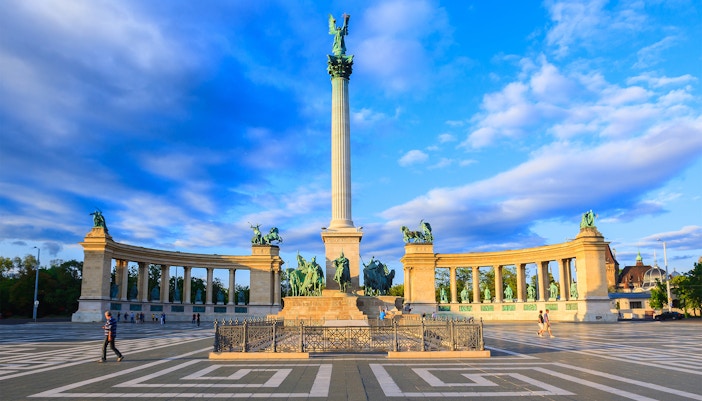
Heroes’ Square
Hősök tere is one of Budapest’s most significant historical and cultural landmarks, and a symbol of Hungarian national identity. Constructed in 1896, it commemorates the 1,000th anniversary of the arrival of the Magyars (Hungarians) in the Carpathian Basin and the founding of Hungary. Walk around the grand square and see the Millennium Monument and the statues representing the seven Magyar chieftains who led the Hungarian tribes.
- Opening hours: Throughout the day
- Duration of visit: 1 hour
- Nearest hop-on hop-off bus stop: Heroes’ Square, Dózsa György Road 88 (BigBus); Heroes’ Square (City Sightseeing)
10am to 1pm
Heroes’ Square is surrounded by some of Budapest’s most visited attractions that you can explore. So choose one – or more! – that suits your time and interest the most.
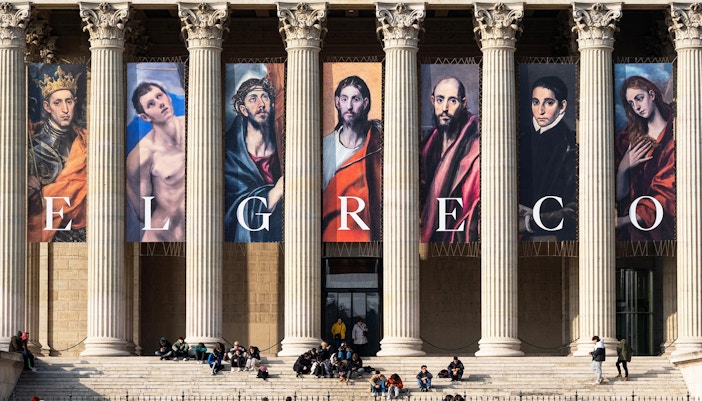
Museum of Fine Arts
The Museum of Fine Arts is one of Hungary’s most prestigious art museums. Housed in a magnificent neo-classical building, it is renowned for its extensive collection of paintings, sculptures, drawings, and decorative arts, dating from antiquity to the late 18th century. Wander the museum and admire the works of masters like Raphael, Titian, Rembrandt, Velázquez, Goya, Monet, El Greco, Rubens, and many others. It is a must-visit for art lovers.
- Opening hours: 8am – 4/6pm
- Duration of visit: 2 to 3 hours
- Nearest hop-on hop-off bus stop: Heroes’ Square, Dózsa György Road 88 (BigBus); Heroes’ Square (City Sightseeing)
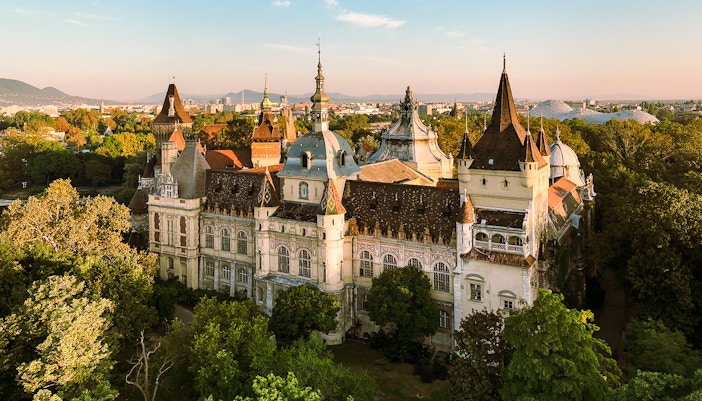
Vajdahunyad Castle
Nestled in City Park is the enchanting Vajdahunyad Castle. Originally constructed as a temporary wood and cardboard structure for Hungary’s Millennium Celebrations in 1896, it was later rebuilt in stone and brick, and features many of Hungary’s historical architectural styles. Its idyllic surroundings – charming courtyards, a lake, bridges, and verdant gardens – make it an ideal spot for leisurely strolls and photography.
- Opening hours: Tuesday to Friday: 10am – 4pm (1 Nov – 31 Mar), 10am – 5pm (1 Apr – 31 Oct); Saturday & Sunday: 10am – 5pm
- Closed on: Monday
- Duration of visit: 2 to 3 hours
- Nearest hop-on hop-off bus stop: Heroes’ Square, Dózsa György Road 88 (BigBus); Heroes’ Square (City Sightseeing)

Budapest Zoo & Botanical Gardens
Dating back to 1866, Budapest Zoo is one of the world’s oldest zoological parks. Home to over 1,000 animal species from around the globe, visitors can explore its habitats like the African savannah and a tropical rainforest. Adjacent to the zoo, the tranquil Botanical Gardens showcase a diverse collection of plant species from Hungary and around the world. With amenities like playgrounds, picnic areas, and cafés, the zoo is an ideal spot for a family visit.
- Opening hours: Monday to Friday: 9am -- 6pm; Saturday & Sunday: 9am -- 7pm
- Duration of visit: 2 to 3 hours
- Nearest hop-on hop-off bus stop: Heroes’ Square, Dózsa György Road 88 (BigBus); Heroes’ Square (City Sightseeing)
1pm to 3pm: Lunch
In Budapest, trying Hungarian cuisine is as much a part of sightseeing as visiting its landmarks and monuments. It is an essential aspect of experiencing the city’s cultural tapestry. With 2 days in the city, you can take the time to slow down and savour its authentic flavours. Tick off some bucket-list experiences as well with a meal at one of these two longstanding establishments.
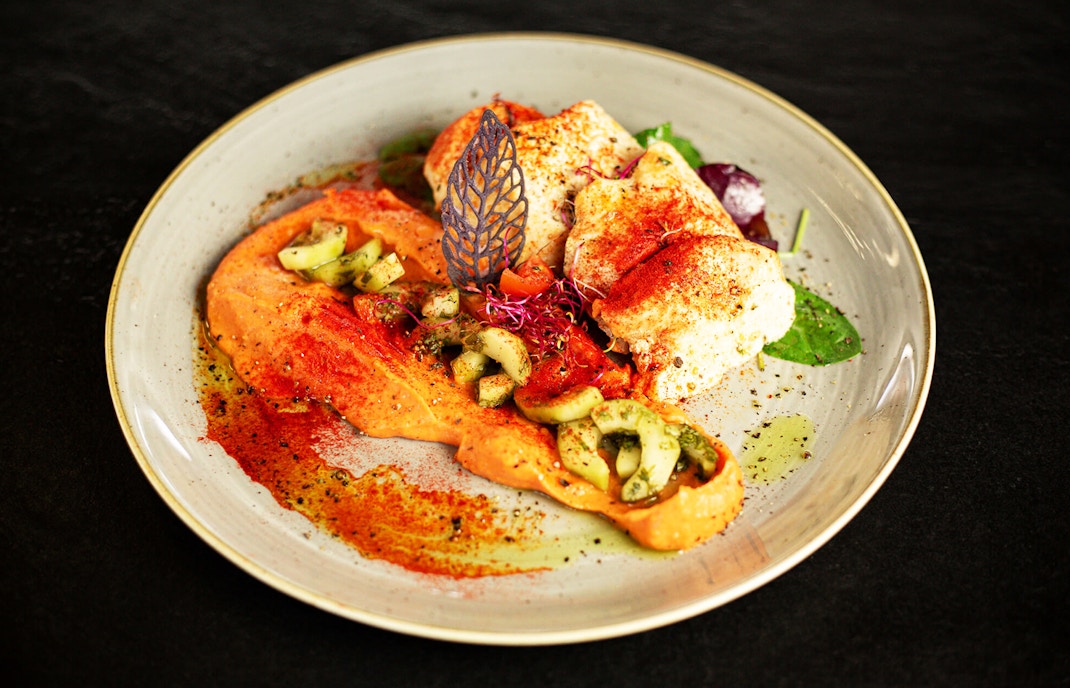
Gundel Cafe Patisserie Restaurant
There has been a restaurant at this spot for over 125 years and Gundel, opened in 1910, is considered the bastion of Hungarian gastronomy. Sample its unmissable dishes – Újházi chicken soup, Palóc, goulash, paprika chicken, Carpathian perc, and Tokaj goose liver. For dessert, try the original Gundel pancake: crepes filled with ground walnuts, raisins, and rum, topped with a rich chocolate sauce.
- Gundel Cafe Patisserie Restaurant | Find on map
- Opening hours: 11.30am – 10pm
- Duration of visit: 1 to 2 hours
- Nearest hop-on hop-off bus stop: Heroes’ Square, Dózsa György Road 88 (BigBus); Heroes’ Square (City Sightseeing)
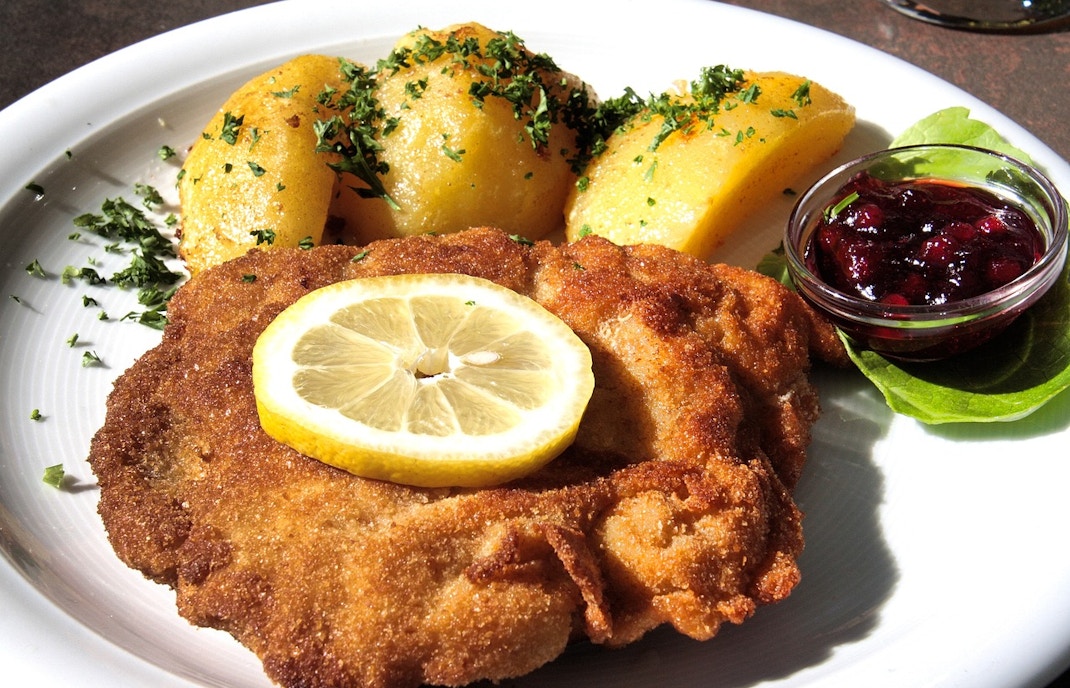
New York Café
Considered the world’s most beautiful café, New York Café, opened in 1894, is one of Budapest’s trendiest eating joints. With ornate interiors and gilded ceilings, it is more reminiscent of an opulent French palace. Try its iconic dishes like the beef goulash and wiener schnitzel. But it is the desserts this place is renowned for. Don’t leave without having the mouthwatering Dobostorta – layered chocolate and caramel cake, or Sachertorte, a chocolate and apricot torte.
- New York Café | Find on map
- Opening hours: 8am – 12 midnight
- Duration of visit: 1 to 2 hours
- Nearest hop-on hop-off bus stop: New York Café, Erzsébet krt. 9-11 (BigBus); New York Palace (City Sightseeing)
3pm to 5pm
Most of Budapest’s museums and other landmarks open by 10am, which means they are more crowded in the mornings. Visiting during the afternoons allows you to explore them with fewer people around.
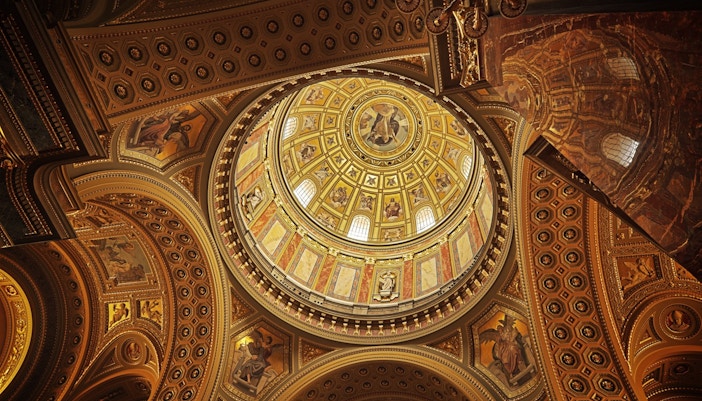
St. Stephen’s Basilica
Hungary’s largest Roman Catholic church, St. Stephen’s Basilica is famous for a rather morbid reason: its most prominent religious relic is the mummified right hand of St. Stephen, who was also the country’s first king. Completed in 1905, its neo-classical and neo-renaissance exteriors are matched by equally impressive interiors, with a soaring dome and stunning frescoes decorating the ceilings. Along with the Hungarian Parliament, it is one of the two tallest buildings in Budapest and probably its most photographed landmark.
- Opening hours: 9am to 5:45pm
- Duration of visit: 1 to 2 hours
- Nearest hop-on hop-off bus stop: Basilica (BigBus); St. Stephen’s Basilica (City Sightseeing)
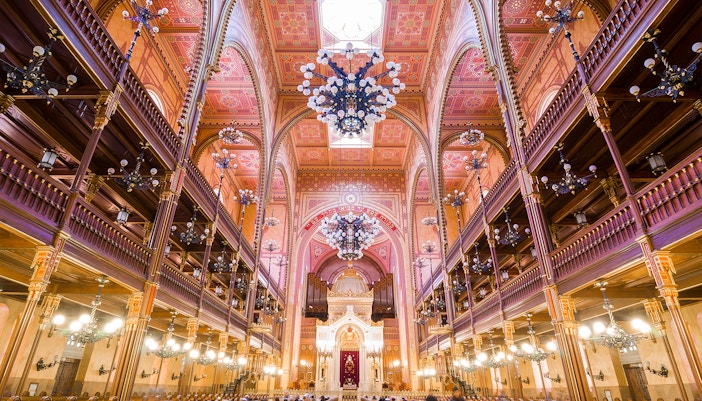
Dohany Street Synagogue
Europe’s largest synagogue and the second largest in the world, Dohány Street Synagogue is located in the heart of Budapest’s Jewish quarter in Pest. Built in a unique blend of Moorish and Byzantine architectural styles, its ornate arches, colourful ceramic tiles, and onion-shaped domes atop soaring towers make it one of the city’s most beautiful buildings. Don't miss the Heroes’ Temple, dedicated to Hungarian Jews lost in World War I, and the Hungarian Jewish Museum next to the synagogue, which houses religious artefacts and a Holocaust Memorial Garden.
- Opening hours in 2024: Sunday to Thursday: May to Sept: 10am – 8pm; Oct: 10am – 6pm; Nov to Dec: 10am – 4pm; Friday: March to October: 10am – 4pm; November to December: 10am – 2pm.
- Closed on: Saturday
- Duration of visit: 1 to 2 hours
- Nearest hop-on hop-off bus stop: Synagogue, Dohány utca (BigBus); Dohány Street Synagogue (City Sightseeing)
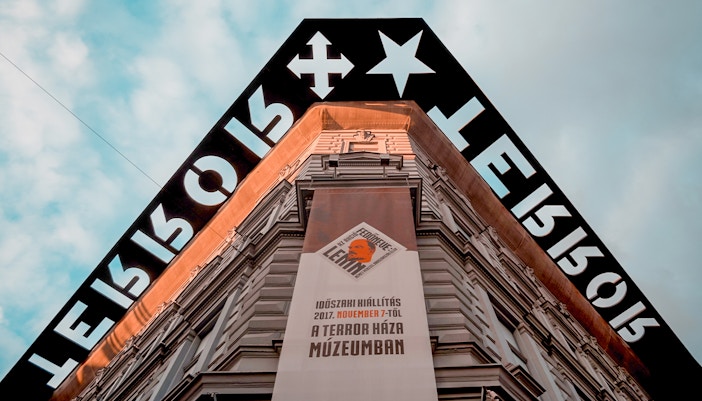
Terror Haza (House of Terror)
If you’re up for an unusual experience that looks into the macabre side of Budapest’s history, visit Terror Háza or the House of Terror museum. It contains exhibits from the oppressive fascist and communist regimes, including torture devices, propaganda materials, and personal accounts, which provide a sobering glimpse into the atrocities committed during these times. Its name is apt as it is housed in the same building where the secret police of these regimes used to interrogate and torture their prisoners. Today, the museum commemorates these victims.
- Opening hours: 9am to 5:45pm
- Duration of visit: 1 to 2 hours
- Nearest hop-on hop-off bus stop: Liszt Ferenc Square, Andrássy út (BigBus); Liszt Ferenc Square (City Sightseeing)
5pm to 11pm
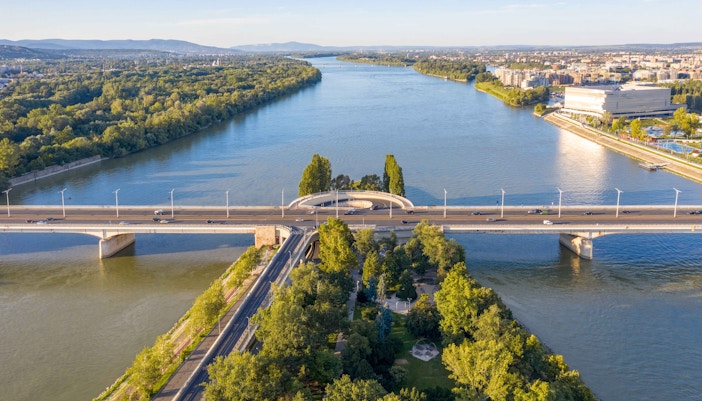
Margaret Island
If you want a respite from your full day of sightseeing, head to Margaret Island, located in the Danube River between Buda and Pest. With a water park, public pools and sports facilities, verdant gardens, and even spaces for concerts and cultural events, it is a popular destination for both locals and tourists seeking relaxation and outdoor activities. If you don’t fancy doing anything other than unwinding, carry a few snacks and a bottle of the famous local Tokaji wine for a lovely picnic.
- Opening hours: Throughout the day
- Duration of visit: 1 to 2 hours
- Nearest hop-on hop-off bus stop: Margaret Bridge, Buda side (BigBus); Margaret Bridge, Buda (City Sightseeing)
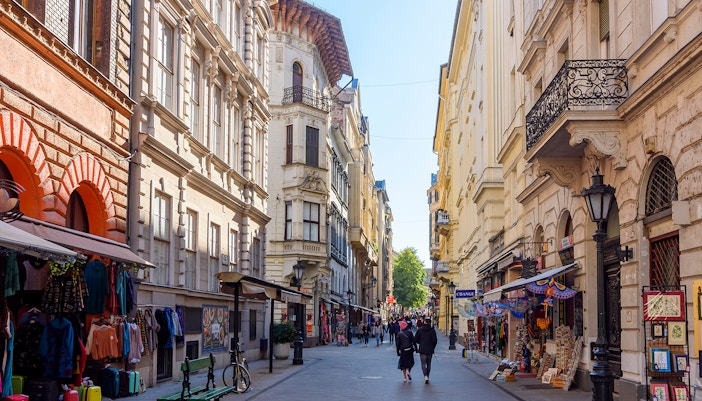
Váci Street
One of Budapest's treasures, Váci Street is a busy thoroughfare that stretches for a mile through the heart of historic Pest. Known for its vibrant atmosphere, it is packed with souvenir shops, boutiques, restaurants, and cafés. You’ll also find some of the city’s most impressive architecture – historical buildings with beautiful facades, charming squares, and statues. Browse through the souvenir shops for mementoes of your visit to Budapest or grab a coffee and a snack in one of the traditional bakeries.
- Opening hours: Throughout the day
- Duration of visit: 1 to 2 hours
- Nearest hop-on hop-off bus stop: Váci Street, Ferenciek tere (BigBus); Parisi Udvar/Hyatt (City Sightseeing)

Dinner at Rosenstein
What better way to round off your stay in Budapest than an exceptional dinner at one of its culinary gems? Rosenstein, situated in District VIII, has been one of the city’s finest eating establishments for over 25 years. Its menu features classic Hungarian and Hungarian-Jewish fare. Don’t miss the traditional goulash, Matzo ball soup, catfish paprikash, beef stew, and roast goose leg, all paired with fine local Hungarian wines. And don’t worry, the restaurant offers several vegetarian options as well!
- Rosenstein | Find on map
- Opening hours: Monday to Saturday, 12 noon to 11pm
- Closed on: Sunday
- Duration of visit: 1 to 2 hours
- Nearest hop-on hop-off bus stop: Keleti Railway Station, Rákóczi út 90 (BigBus); Keleti Railway Station (City Sightseeing)
Frequently asked questions about exploring Budapest in 2 days
Explore Margaret Island with your partner and have a picnic in its gardens. Stroll along the banks of the Danube together. Take a ride on the ferris wheel, followed by a musical performance at the Hungarian State Opera House. Go on a sightseeing sunset cruise on the river and enjoy a romantic meal at one of the city’s charming restaurants.
There are plenty of activities to do in Budapest in 48 hours with kids. Spend an enjoyable morning at the Budapest Zoo, the botanical gardens, and Vajdahunyad Castle. Museums like the Light Art Museum and the Hungarian Railway Museum will prove fascinating for children of all ages. You could also opt for a trip to the Aquaworld Water Park.
If you’re looking to cover the must-see places, don’t miss out on Buda Castle, the Hungarian Parliament, Heroes’ Square, and St. Stephen’s Basilica. Also, you cannot come to Budapest and not visit the Gellért Thermal Baths, Szechenyi Baths, or any of the city’s many other thermal spas. And don’t forget to make time for a sightseeing cruise on the Danube – it’ll be one of your most memorable experiences.
Certainly! While your trip will be a lot more packed than when you visit Budapest for 48 hours, you can still enjoy the city’s best experiences. We recommend keeping Buda Castle, the Hungarian Parliament, one of the thermal baths, a sightseeing Danube river cruise, and a meal at one of the city’s finest Hungarian restaurants or historic coffeehouses on your list of things to do. If you have the time, check out one of the iconic ruin bars. Or better still, use our Budapest in 1 day itinerary to plan your visit.
